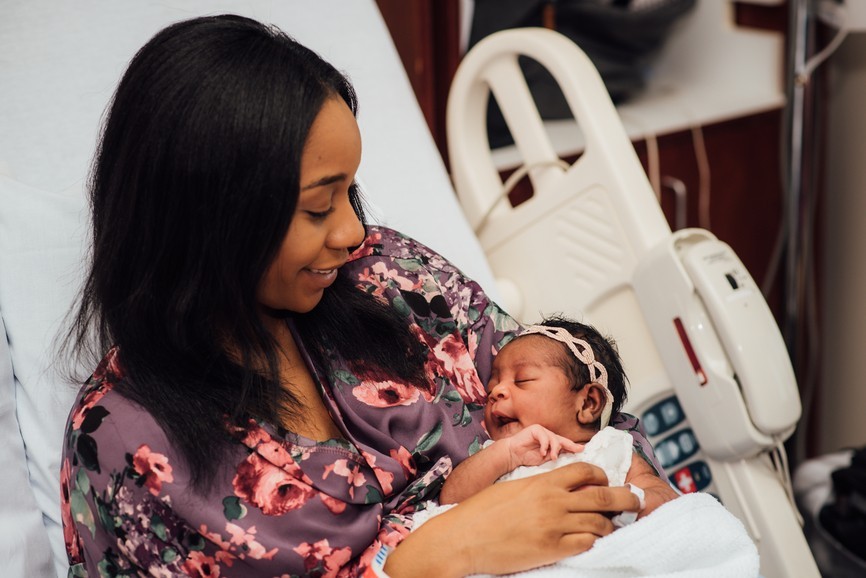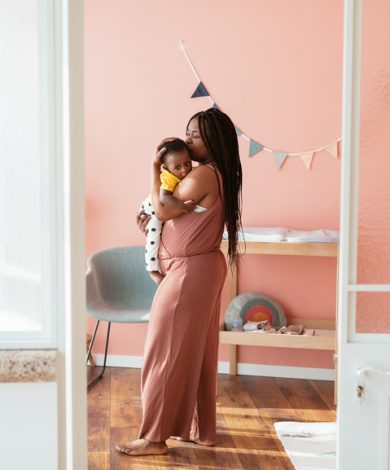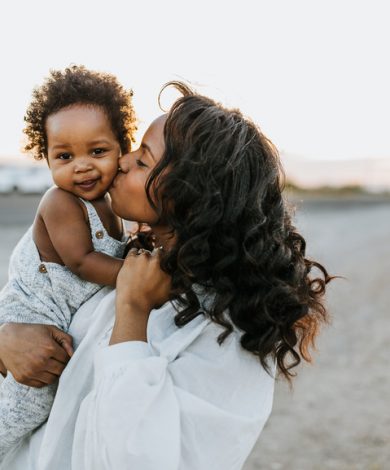I'm fascinated by relaxin. If you’re not familiar, it’s a hormone produced during pregnancy to…
MindsetUncategorized
All Birth Is Natural: Making Peace with an Unexpected C-Section
November 22, 2021 • By Devon Loftus

It was 7:50 pm and almost 4 hours prior, down to the minute, you were born. I was in surgery. And my life as a new mother had just begun. I felt a bit hazy, incredibly tired and oh-so hungry. But as I held you in my arms, two things spoke the loudest: that I loved you so much more than I could ever have imagined. And that I would be processing our birthing experience for some time.
That processing was multicomplex and layered. There was the need to process the fear and trauma I felt during my 41-week ultrasound when the technician quieted and I knew something was wrong. The fear of little to no amniotic fluid left and shame that maybe I had done something to cause it. The fear of being induced. And then when you started to decelerate, the dread and anguish at the thought of losing my baby. But that fear passed quickly; we were lucky. And when it came time to lay down on the cold, steel table and meet you, I felt empowered and so grateful that you were safe. I had chosen a C-section as the safest way to get you out and I felt good about that decision.
So, when I sat there at 7:50 pm and played the day in my mind, it made me sad to realize I felt shame for my choice. I felt ashamed for not laboring like I had planned to. I felt shame for delivering my baby the way I knew I needed to.
At first, I carried that shame with me. I nursed it while nursing you. I tended to it in the shower alongside my scar. I spent time unable to look in the mirror or at pictures of myself, cringing from the feeling that I failed the girl I saw. There was the grieving process of birth not going the way I had planned; a process I could move with. But the shame had no place to go, because it wasn’t meant to be there in the first place. It wasn’t wholly mine. And I couldn’t quite figure out where it came from.
I wanted a “natural”, unmedicated birth. Preferably in water. And preferably with my favorite music playing in the background. I submerged myself in baby classes with a focus on “natural” birthing, listened to Hypnobirthing tapes before bed and recited mantras when I needed some added focus. We hired a doula. We spoke in depth about what I could anticipate needing during labor — a hand to squeeze, lavender to smell, a mindset shift. I even did the ice cube test, holding ice to my wrist and breathing through the pain. “This hurts,” I’d say smiling, aware that labor would be far worse and simultaneously knowing that I could weather it all.
In class, we were educated on C-section rates in the U.S., primarily NJ, and how high they were. We were encouraged to advocate for ourselves when it came to declining intervention. We were ready with what to say to doctors and nurses, how our midwife and doula would support us. I read story after story about “natural” births and how beautiful they are. How monumentally transformative, relaxed and freeing they could be. And I looked forward to sharing my story with others in that space.
But that time never came. I had a C-section — who would be proud of me for choosing that option? Who in the “natural” birthing space would support me now?
Memories of a certain midwife in the practice popped into my mind, “Well, it’s too bad you’re having the baby in the hospital,” she said, “but at least you’re with us. Usually people end up here after a C-section and by then, it’s too late.” The shame was there all over again, soaking me through like the bloody diaper I wore or my milk-drenched shirt. And it was time to let it go.
Eventually, I turned to a friend and shared what I had been carrying. “You are a mother,” she said, “no matter how you gave birth.” And in that moment, the heaviness dissipated. All I saw was your face in my arms.
As of 2018, statistically speaking, C-section rates are higher in the U.S. than many other countries,* with certain states well above average.** There is a real source of alarm here; a means to educate and understand why this is happening.
There are times where a C-section may not be the first needed option but may be construed to the patient as such. There are times where a patient may not want a C-section, but may feel coerced and shamed into getting one. And there are times where emergency C-sections are needed; often traumatic and leaving the patient feeling powerless.
These are all very real experiences, alongside many more. There are also C-section experiences that can feel empowering, encouraging, and validating. Experiences that can be life-saving for mother and/or child. Or chosen, scheduled C-sections instead of laboring, because it’s what the mother feels is in her best interest.
When it comes to birth, it is a whole world of grey space — there is no such thing as a black or white way of having a child. No such thing as “natural” vs. “unnatural”.
Birth sits alongside death as one of the very few aspects of life we have little control over.
All we can control is how we move through the waves and how we support ourselves, hopefully with compassion, acceptance, integrity and love. It is wonderful to remind ourselves that our bodies know how to birth, that we are beyond capable of delivering a child without intervention. But what happens when our bodies don’t move the way we’re told to expect they will? What happens when our best choice is often a stigmatized one?
Normalizing birth as natural and intuitive is incredibly important work. Normalizing birth as messy, chaotic, and unknown is just as important. The goal is to set mothers up for the whole spectrum and what it entails — reminding them that they have strength, capability, and autonomy. Reminding them that they know what is best for themselves and their children.
A mother NEEDS to listen to her intuition. It’s a new baby, much like the newborn she holds. And it needs care, kindness, and respect — however it looks. So, although I didn’t get my unmedicated birth, I did get my baby, which was all I wanted and a privilege at that.
There was no water, including amniotic —after you were born, it was the first thing the doctor said out loud. But there was music — Yes’s “I’ve Seen All Good People” came on in the operating room, one of our favorite songs, and I knew everything would be okay. There were mantras — I held the hand of my nurse and my midwife (both of whom were imperative to me feeling empowered) and repeated, “I can do this,” as my spinal was administered.
And there was peace — the peace I had in knowing that you were okay, in knowing that I was strong enough to birth my baby whichever way I needed to. Peace in knowing that I listened and acted for the both of us, that this was just the beginning of that.
And there was you.
The rest is history, or rather, ours.
It takes time to process our birth stories. Sometimes we don’t know where to start. If this is you, click here to learn more about the power of storytelling.
Most births don’t go according to plan. To help soften the blow, try embracing The No Plan Plan.
Childbirth is…a lot. That’s why we are here. Check out our upcoming events here and join our newsletter for up to date info on content and events.
SOURCES:
*Global Cesarean statistics
**State Cesarean statistics



